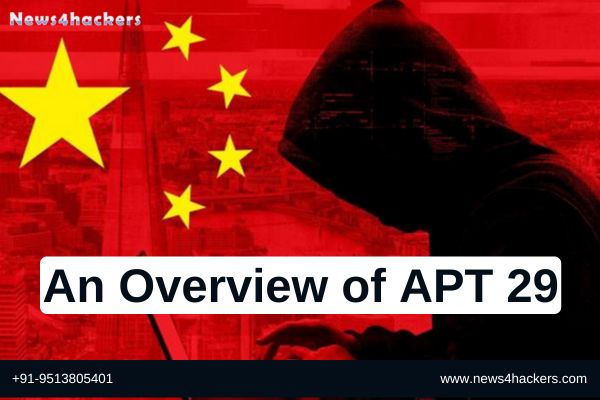An Overview of APT 29: The Elusive Threat Group

An Overview of APT 29: The Elusive Threat Group
Advanced Persistent Threat (APT) 29, which is also known by a number of other names, is a highly sophisticated cyber espionage group that is thought to be affiliated with the government of Russia. This organization is well-known for its sophisticated strategies, its dogged determination, and the extensive operational security measures it employs.
In-Depth Look at APT 29
Not only does APT 29, also known as Cozy Bear, stand out for its technological expertise, but it also stands out for its strategic patience and subtlety. The activities of this organization have frequently taken place in accordance with the goals of the Russian state, which has resulted in important geopolitical consequences.
Other Known Names
In addition, APT 29 is frequently referred to by a number of other titles, which are reflective of the numerous operations and campaigns it has carried out over the years. There are many prominent aliases, including the following:
- Cozy Bear
- The Dukes
- Office Monkeys
- CozyDuke
- Yttrium
These identities are frequently included in information security reports and assessments, which serve to emphasize the wide and varied cyber actions carried out by the group.
Historical Context and Notable Campaigns
At the very least, APT 29 has been operating since the middle of the 2000s. It has been tied to a number of high-profile cyber espionage attacks over the course of its existence, which is a reflection of its ever-evolving strategies and continuous efforts to infiltrate and exploit targets. Among the most famous campaigns now are:
- 2014 State Department and White House Breaches: After successfully breaking into the networks of the United States Department of State and the White House in 2014, the advanced persistent threat known as APT 29 received a lot of attention. In spite of the efforts that were made to remove them, the organization was successful in removing critical information and maintaining access to it for extended periods of time.
- DNC Hack (2016): Cozy Bear was involved in the infiltration of the Democratic National Committee (DNC) during the presidential election in the United States of America in 2016, together with another Russian advanced persistent threat (APT) organization known as Fancy Bear (APT 28). In the course of this campaign, critical emails were stolen and then leaked, which resulted in serious political implications.
- SolarWinds Supply Chain Attack (2020): The attack against SolarWinds is considered to be one of the most sophisticated cyber espionage attacks believed to have been carried out by APT 29. The gang was successful in inserting a backdoor, known as Sunburst, into upgrades of the Orion network management software. This was accomplished by compromising the software supply chain of SolarWinds Corporation. Because of this, they were able to penetrate a large number of high-profile organizations, including government institutions in the United States as well as private sector businesses, without being discovered for several months.
Typical Techniques
The Advanced Persistent Threat (APT) 29 uses a wide variety of sophisticated methods to infiltrate targeted systems and keep access to those systems.
Techniques such as the following are among their most visible:
| Spear Phishing | Emails that contain malware attachments or links are frequently sent to victims by APT 29 through the use of spear phishing technology. These emails are extremely targeted and are intended to appear real, frequently imitating sources that are considered to be reliable. |
| Custom Malware | It is well known that this group is responsible for the development of specialized strains of malware, including CosmicDuke, MiniDuke, Cobalt Strike, and SeaDuke. These families of malicious software had stealth, persistence, and data exfiltration in mind when they were developed. |
| Living off the Land | When it comes to carrying out its operations, APT 29 frequently makes use of genuine system tools and applications, which makes detection more difficult at times. The utilization of PowerShell scripts, Windows Management Instrumentation (WMI), and various other native utilities are included in this endeavor. |
| Credential Harvesting | The organization frequently concentrates on stealing credentials in order to obtain access to sensitive systems and to keep a footing within networks that are being attacked. A few examples of techniques include keylogging, credential dumping, and the utilization of programs such as Mimikatz. |
| Exploitation of Zero-Day Vulnerabilities | It is well known that APT 29 takes advantage of zero-day vulnerabilities in order to obtain initial access or escalate privileges within the networks that are being targeted. Their technical excellence is demonstrated by the fact that they are able to identify and exploit vulnerabilities of this nature. |
| Stealth and Persistence | In order to maintain long-term access to their targets, APT 29 places a significant amount of importance on this. In order to avoid being discovered, they make use of a variety of evasion strategies, including obfuscating their code, utilizing encrypted connections, and deploying backdoors for remote access. |
Advanced Techniques and Tools
The APT 29’s toolkit is extensive and is always being updated. The following are some of the most distinguished instruments and methods that they employ:
- WellMess and WellMail: Malware strains that are specifically created for the aim of espionage, with the intention of evading detection and facilitating the exfiltration of data.
- Cloud-based Command and Control: The advanced persistent threat known as APT 29 frequently employs genuine cloud services for command and control (C2) communications. In order to avoid detection, they blend their malicious traffic with typical, innocuous activities.
- Fileless Malware: APT 29 is able to execute harmful code directly in memory by utilizing fileless malware tactics. This makes it impossible for typical antivirus solutions to detect the presence of these threats.
- Multi-Stage Malware: Additionally, their malicious software frequently consists of numerous stages, with basic loaders retrieving more complex payloads once they have gained access to a target network. Through the use of this modular method, greater flexibility and stealth are made possible.
Impact and Mitigation
The operations of APT 29 have a significant impact, negatively affecting not just national security but also political stability and commercial interests on a worldwide scale. There is a high risk that they could compromise vital infrastructure and gain access to sensitive information using their abilities.
Mitigation Strategies
The following are some of the complete cybersecurity measures that enterprises should employ in order to protect themselves from APT 29:
1. Enhanced Monitoring: There is a possibility that anomalies that are suggestive of an APT 29 infiltration can be discovered by continuous monitoring of network traffic and user activity.
2. Threat Intelligence: By keeping abreast of the most recent threat information and indicators of compromise (IOCs) associated with APT 29, one can improve their ability to detect and respond to threats at an earlier stage.
3. Multi-Factor Authentication (MFA): Even in the case that credentials are stolen, multi-factor authentication (MFA) can be used to assist prevent unwanted access.
4. Regular Patching: Making sure that all of the systems have the most recent security patches installed can help reduce the likelihood of vulnerabilities being exploited in a way that is already known.
5. Employee Training: It is possible to lessen the risk of social engineering assaults being successful by providing staff with education on threats such as phishing and safe internet behaviors.
Who is at Risk?
The primary targets of APT 29 are organizations that are of strategic relevance to the Russian government, such as the following:
Government Agencies
Due to the fact that they possess information that is both important and sensitive, ministries, intelligence agencies, and defense departments are potential targets.
Diplomatic Institutions
It is common practice to concentrate on diplomatic missions and embassies in order to get knowledge regarding international relations and foreign policy.
Think Tanks and Research Institutions
Many times, organizations that are engaged in policy research and strategic analysis are the targets of attacks because of the significant information and insights they provide.
Private Sector Companies
Businesses operating in essential sectors, such as the energy sector, the telecommunications industry, and the financial sector, are particularly vulnerable, particularly those who are engaged in vital projects or that contain valuable intellectual property.
Political Organizations
In order to acquire intelligence about political plans and election procedures, the target organizations include political parties, election committees, and other organizations that are associated with politics.
Non-Governmental Organizations (NGOs)
Also in danger are non-governmental organizations (NGOs) that work on causes that are of interest to the Russian government, such as human rights.
Conclusion
Among the cyber espionage groups that are active in the modern era, APT 29 continues to be one of the most powerful and evasive. As a result of their sophisticated methods, dogged determination, and concentration on high-value targets, they pose a tremendous risk to the national security and strategic interests of nations all over the world. For the purpose of mitigating the danger that is posed by adversaries with such advanced capabilities, organizations need to maintain vigilance, implement stringent cybersecurity measures, and remain informed on the most recent threats.
About The Author:
Yogesh Naager is a content marketer who specializes in the cybersecurity and B2B space. Besides writing for the News4Hackers blogs, he also writes for brands including Craw Security, Bytecode Security, and NASSCOM.
READ MORE ARTICLE HERE














